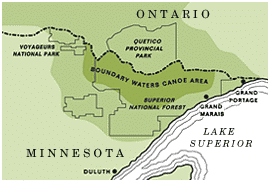
Pollution
Court Upholds State’s Sulfate Rules
A Ramsey County Court judge upheld Minnesota’s restrictions on sulfate pollution in waters that host wild rice plants, denying a Minnesota Chamber of Commerce challenge that the rules were vague and arbitrarily applied.
MPCA Board Approves Haze Rules
The citizens’ board of the Minnesota Pollution Control Agency approved a controversial set of rules intended to reduce the amount of haze over northern Minnesota.
MPCA Board to Revisit Haze Rules
After delaying a decision on a plan to reduce haze over northern Minnesota, the Minnesota Pollution Control Agency’s citizen’s board will attempt to approve the plan today.
State Regulators Delay Haze Decision
The Minnesota Pollution Control Agency’s citizen’s board decided to delay a planned vote this week on measures to reduce haze in northeastern Minnesota.
Federal Agencies Pan State Haze Plan
U.S. Forest Service and National Park Service officials are critical of Minnesota’s plans to regulate pollutants causing haze over the Quetico-Superior region.
Cravaack: PolyMet Review by October
Minnesota 8th District Representative Chip Cravaack expects the revised Draft Environmental Impact Statement for the PolyMet precious metal mine near Babbitt to be released by October.
Northshore Mining Fined $240,175
Northshore Mining was fined $240,175 by the Minnesota Pollution Control Agency after its taconite processing plant in Silver Bay was cited for 30 air quality violations in 2010 and 2011.
Exemption Could Avoid Clear Air Retro-Fit
A proposed exemption in the Clean Air Act could allow Minnesota’s largest coal-fired power plant to avoid a costly retro-fit to reduce the haze over the Boundary Waters and Voyageurs National Park.
Northshore Sites Some of State’s Top Greenhouse Gas Emitters
A new EPA database places some of Minnesota’s top greenhouse gas emitters in Northeastern Minnesota and the North Shore.
Minnesota Seeks Sulfate Research
The Minnesota Pollution Control Agency is asking scientists to propose studies assessing the effects of sulfate pollution on the state’s wild rice.
Oil Spill Impact on Loons, Pelicans Studied
A major, mutli-year study to determine the impact of the Gulf of Mexico oil spill on Minnesota’s loon and pelican populations is underway, the Minnesota Department of Natural Resources announced yesterday.
Wild Rice Sulfate Rules Studied, Suspended
A $1.5-million study will decided whether Minnesota water quality standards for wild rice waters need to be amended, but current limits on sulfates in water where wild rice grows won’t be enforced in the meantime.
Wild Rice Rally to Greet Governor
Environmental advocates will greet Minnesota governor Mark Dayton with a rally in support of wild rice protection when he visits northern Minnesota for the walleye fishing opening this weekend.
Will Oil Spill Impact Loon Numbers?
With the ice now out on most Quetico-Superior area lakes, experts are wondering if the region’s common loon population will have been impacted last year’s Gulf of Mexico Oil spill.
Sulfates Standard Change Proposed in House
Legislation to markedly roll back the allowable amount of sulfate in wild rice waters in Minnesota is being proposed in the Minnesota House where proponents say current standards are too strict and not based on solid science.
Old Mine Drainage Worries Advocates
The drainage of pollutants from an abandoned mine near Ely coupled with the Minnesota Pollution Control Agency allegedly lax oversight of the situation has environmental advocates concerned about the state’s ability to oversee the large copper-nickel mines proposed for the area.
Coalition to Sue Over Park Air Quality
A coalition of environmental organizations intends to sue the Environmental Protection Agency and two other federal agencies over haze pollution in national parks and wilderness areas, including Voyageurs National Park and the Boundary Waters Canoe Area Wilderness.
Lawsuit Aims to Loosen Wild Rice Water Standards
A lawsuit filed Friday by the Minnesota Chamber of Commerce seeks to loosen water quality standards in areas where wild rice is grown, saying current regulations are too restrictive and based on faulty science.
Endocrine Disruptors Found in Kabetogama
Chemicals that cause endocrine system disruption in aquatic animals were found in Kabatogama Lake, one of the lakes that makes up Voyageurs National Park, according to a recent study.

